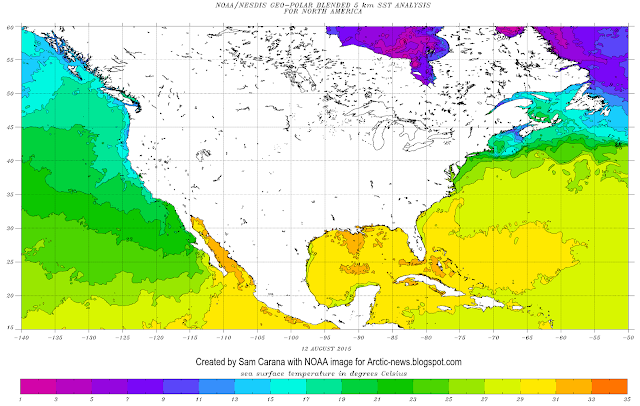There are a number of reasons why sea ice could fall dramatically over the next few weeks.
There is quite a difference between the sea ice that was 5 meters thick north of Greenland in 2012 and the ice that is present there now. The image on the right shows the north-east corner of Greenland on the bottom left. There is almost no ice north of this point.
Thick sea ice is virtually absent compared to the situation in the year 2012 around this time of year, as illustrated by the image below that compares sea ice thickness on August 20, 2012 (left) with August 20, 2015 (right), from an earlier post.
Furthermore, sea surface temperatures are very high. The North Pacific, on August 23, 2015, was exactly 1°C (1.8°F) warmer than it was compared to the period from 1971 to 2000 (see Climate Reanalyzer image right).
As the image below shows, sea surface temperature anomalies are very high around North America. On August 23, 2015, sea surface temperature anomalies as high as 6.4°C (11.5°F) were recorded in the Bering Strait.
This is where warm waters from the Pacific Ocean are flowing into the Arctic Ocean.
The image below shows sea surface temperatures on August 22, 2015, indicating that a huge amount of ocean heat has accumulated in the Atlantic Ocean off the coast of North America.
The Gulf Stream is carrying much of this warm water toward the Arctic Ocean. On August 21, 2015, sea surface temperatures near Svalbard were as high as 17°C (62.6°F), a 12°C (21.5°F) anomaly, at the location marked by the green circle on the image below, showing sea surface temperatures in the top panel and sea surface temperature anomalies in the bottom panel.
 |
| [ click on image to enlarge ] |
More open water increases the chance that storms will develop that will push the last remnants of the sea ice out of the Arctic Ocean, as discussed in earlier posts such as this one, while storms can also mix warm surface waters all the way down to the seafloor, as discussed in this earlier post. The Climate Reanalyzer forecast for August 26, 2015, on the right shows strong winds both in the Bering Strait and the North Atlantic.
Typhoons increase this danger. The Climate Reanalyzer forecast for August 27, 2015, below shows a typhoon in the Pacific Ocean close to the Arctic Ocean.
The situation is dire and calls for comprehensive and effective action, as discussed in the Climate Plan.
On August 21, 2015, sea surface temperatures near Svalbard were as high as 17°C (62.6°F), a 12°C (21.5°F) anomaly, at...
Posted by Sam Carana on Monday, August 24, 2015



















































